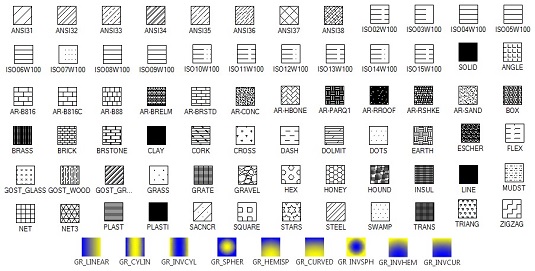

Drafting patterns usually contain sizes from 0.04 to 1 inch (1–25 mm) model patterns usually contain sizes from 2 to 20 inches (50–500 mm). Drafting patterns are used to symbolically denote materials such as steel, concrete, sand, etc.ĭrafting patterns are typically defined with smaller numbers than model patterns. If you import the pattern at scale 1 and print at 100% zoom, the pattern’s dimensions on paper will be exactly as specified in the file, regardless of view scale. Model patterns appear denser at coarser view scales and sparser at finer ones.ĭrafting patterns are defined in paper units. A 2-meter-tall wall with a 200×400 mm brick pattern will have 10 courses. An 8×16 inch brick pattern will show exactly 12 courses on an 8-foot-tall wall. They are defined and display in model units. Model patterns are used to depict real-world elements, such as bricks, shingles, tiles, etc. There are two types of fill patterns in Revit: model and drafting. The lighter areas of the image are more transparent than the darker areas.

Turn on the Section Box and you will even get the toposurface in section.Īn image file can also be used to define a transparency in a render appearance asset, as shown in the image below. You can lock the view and add dimensions, tags, and notes. Once the opening is set to be transparent in elevation and the glass sub-category is turned off, you can see though the windows, as shown in the image below.Īnother option is to adjust a 3D view to “front.” This is a flat view, just like an elevation, but is still technically still a 3D view. Once the opening is set to be transparent in elevation and the glass sub-category is turned off, you can see though the windows, as shown in the image below. To achieve that, simply select the opening and check Elevation on the Options toolbar.

The trick here is to edit the opening in the family so it is transparent in elevation, as shown in the third image. Even turning off the glass material in a view’s Visibility Graphics Overrides (VG) will not allow you to see through the “opening,” as seen in the second image. In any elevation view, materials are not transparent, as you can see in the left-hand image below (regardless of what Visual Style is set to). Materials are only transparent in 3D views! The following images will explain this further and present you with a couple of options. You can now make changes to this material without affecting other materials. Later in this article you will see an example of this which shows a chain-link fence asset being loaded into a material.įinally, when the appearance asset has been duplicated, you can expand the information section and rename the asset. Note: Another option, rather than duplicating the asset, is to import an asset from the library. Click the Duplicate This Asset icon in the upper right. Changing the new material will affect the original material. Once you have duplicated a material, the two carpet materials in this example now indicate they both share the same appearance asset. Before we duplicate it, notice the appearance asset named Red is not shared (see arrow No. In this example, we will right-click on Carpet (1) and duplicate it. If you duplicate a material in your model, the appearance asset will be associated to the new material and the material you copied it from! Not following these steps results in multiple materials being changed when only one material was intended to be modified. Many experienced Revit users still do not fully understand this process. The process has changed significantly from previous years.
#Understanding object types in wilcom hatch how to
It is important to know how to properly duplicate a material in your model so you do not unintentionally affect another material. Via Understanding Autodesk Revit Materials | Cadalyst. These modules are optional and can be added or deleted as needed however, most materials have an appearance asset, which cannot be deleted.

Assets are modules, if you will, that better define a material. Some of the information represents elements you can touch and see when the building is complete, while some does not. Consider the simple illustration at right: This box represents the primary components of a material in Revit. To better understand assets, let\’s first talk about the overall concept of a material in Revit 2014. This is not possible after type-widening them to string.Starting with Revit 2013, there is a new term that users must become familiar with: assets. Take the following third-party function, for example: function describePerson(person: and the compiler can know that both values of alex.hobbies fulfil the hobby value. We’ve all been in situations where we used a library that had been typed sparingly. Simohamed Marhraoui Follow Vue and React developer | Linux enthusiast | Interested in FOSS Understanding infer in TypeScript


 0 kommentar(er)
0 kommentar(er)
